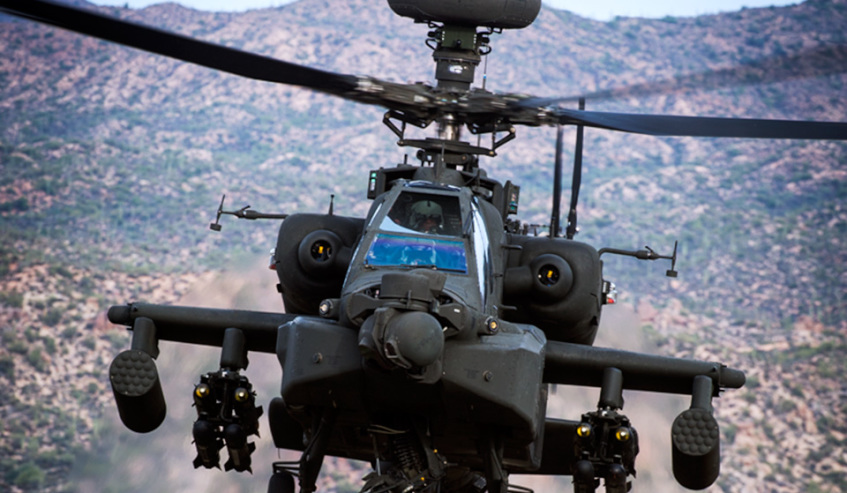The Commonwealth government has been praised for its decision to replace its fleet of Airbus-built Eurocopter Tigers with 29 Boeing-built Apaches, but is the Australian Army adequately equipped and mentally prepared to deploy these platforms effectively?
To continue reading the rest of this article, please log in.
Create free account to get unlimited news articles and more!
In January, former Minister for Defence Linda Reynolds announced the selection of the Boeing AH-64E Apache Guardian to replace the Australian Army’s existing fleet of 24 Airbus-built Eurocopter Tigers, as part of the LAND 4503 Armed Reconnaissance Helicopter (ARH) program.
Australia will procure 29 ready-built Apaches from 2025 for approximately $4.5 billion.
The AH-64E Apache is billed as one of the world’s most advanced multi-role combat helicopters, deployed by Australia’s major strategic allies, including the US, Singapore, Indonesia, South Korea, Japan, Taiwan and the UK.
“This new ARH capability will strengthen Australia’s armed reconnaissance force to better shape our strategic environment and deter actions against our national interest,” Minister Reynolds said following the selection announcement.
The decision was largely welcomed by policymakers, Defence officials, industry, and analysts, who noted the capability benefits associated with operating an Apache fleet.
Malcolm Davis, senior analyst at the Australian Strategic Policy Institute (ASPI), said that while the “much heavier” Apache has half the range of the Tiger —257 nautical miles compared to 430 — it features a “fully developed” suite of mission systems, including advanced satellite communications and the Link 16 tactical data network.
“The advanced digital connectivity of the Apache is a clear factor in its favour,” he writes,
“In particular, the Apache can connect with and control armed drones through its manned–unmanned teaming (or MUM-T) system, a feature the Tiger lacks.
Davis also notes that the Apache has more than double the rounds of 30-millimetre ammunition.
This, he adds, is in addition to the benefits of interoperability, economies of scale, and logistics, given the Apache deployment by allied forces.
But will the upgrade alone strengthen the Australian Army’s capacity to ward off new and advanced threats?
Many observers, including Davis, argue that replacing the Tigers should be the first of many steps required to adequately enhance Army capability.
According to Davis, the Apaches should form part of a new “networked system of capabilities”.
“A key failing of the Tiger has been its inability to network with other elements of the Australian Defence Force, and the new platform must plug and play seamlessly and securely with existing army and ADF forces from the outset,” he writes.
“The new helicopter is one part of a team of crewed and un-crewed platforms.”
Davis argues that Army should deploy the new platforms alongside un-crewed aerial vehicles and armed autonomous ground vehicles, supporting ‘manned–unmanned teaming’ in the future battlespace.
“What’s most important is that the decision should reflect a land-warfare vision that includes large-scale use of armed autonomous systems in the air and on land,” he continues.
“Adversaries will be taking advantage of the military power of such systems to complement — or even replace — crewed systems, and if our own defence organisation doesn’t, Australia will be at a disadvantage.”
To accommodate this vision, Davis argues that Defence should invest in battlespace command and control built to resist countermeasures such as electronic warfare, cyber-attack and kinetic attack.
“Such a capability needs to embrace the ‘small, cheap and many’ approach of ‘command clouds’ operating in the air, over land and even from space, using low-cost, small and easily deployable components.
“Very high altitude, long-endurance UAVs operating in near space can complement locally developed and launched small satellites and constellations of smart cubesats to provide tactical communications and intelligence, surveillance and reconnaissance support to swarms of lethal autonomous weapons.
“In such a scenario, an attack helicopter would hang back, managing the swarms via the command cloud, and avoid needlessly putting itself at risk over what will be an intensely contested battlespace.”
However, developing a new deployment strategy isn’t the only step required to maximise the Apache’s effectiveness.
According to Senator for NSW, retired Major General Jim Molan, effective deployment of the Apache also requires a new mindset from Army, beginning with a rebrand from ‘Armed Reconnaissance Helicopter’ to ‘Attack Helicopter’.
Molan claims that this small change would make a significant difference, mentally preparing Australia’s forces for the growing likelihood of conflict in the region.
“In our current strategic environment where war between the US and China is not just possible because both sides are armed to the teeth, but far more likely than most are prepared to admit, thinking like this from a different era where we could pretend that our helicopters did not kill our enemies but were armed just for reconnaissance, reflects a national weakness we cannot afford,” he writes in an opinion piece published by Defence Connect.
“The Apache is an attack helicopter; it is used throughout the world as a combat helicopter to destroy enemies.”
The retired MAJGEN reflects on his military experience as Chief of Operations of the Multinational Force in Iraq, noting that US forces used Apaches, along with tanks, in what was described as an “insurgency”.
“Australia got away with being ashamed or embarrassed about combat capability from a previous era where there was little threat and no real regional enemies,” Molan continues.
“Now, in the most strategically uncertain period for 75 years, when not only may we have to support alliance forces by deploying small combat forces to distant parts of the world as we have been doing for decades, but must also now have a military that is ready to fight a peer or near-peer competitor, such as China.”
He adds: “Let’s start realistically calling these machines what they are, otherwise we might start to believe our own fears, and think that they can only be used for armed reconnaissance.
“Change the name to make it honest and we take one very small step towards shaping an attitude to combat and winning that Australia desperately needs.”
Molan goes on to question the decision to procure just 29 Apaches, suggesting that more would be needed to adequately defend the country in the event of a war.
“[For] future regional wars between our ally the US and China, or in a fight for national survival, the ADF lacks lethality, mass and survivability,” he writes.
“We are not strong enough; we are not big enough and we cannot fight for long enough.”
With delivery of Army’s Apache fleet scheduled to begin in 2025, Defence has three years to devise a plan that maximises the effectiveness of the platforms in the future battlespace and redefine their use in an increasingly precarious geopolitical environment.
Get involved with the discussion and let us know your thoughts on Australia's future role and position in the Indo-Pacific region and what you would like to see from Australia's political leaders in terms of partisan and bipartisan agenda setting in the comments section below, or get in touch with
Charbel Kadib
News Editor – Defence and Security, Momentum Media
Prior to joining the defence and aerospace team in 2020, Charbel was news editor of The Adviser and Mortgage Business, where he covered developments in the banking and financial services sector for three years. Charbel has a keen interest in geopolitics and international relations, graduating from the University of Notre Dame with a double major in politics and journalism. Charbel has also completed internships with The Australian Department of Communications and the Arts and public relations agency Fifty Acres.

 Login
Login








